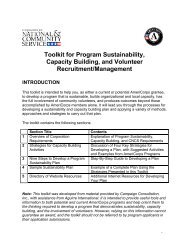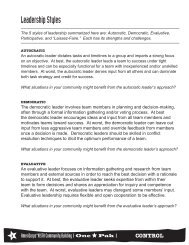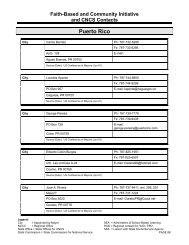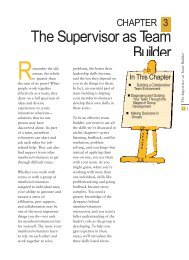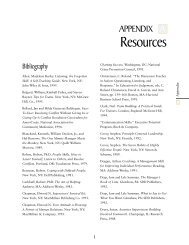MAKE IT LAST FOREVER: THE ... - National Service Resource Center
MAKE IT LAST FOREVER: THE ... - National Service Resource Center
MAKE IT LAST FOREVER: THE ... - National Service Resource Center
Create successful ePaper yourself
Turn your PDF publications into a flip-book with our unique Google optimized e-Paper software.
part of teaching and learning,<br />
and service impacts all<br />
elements of academic and<br />
extracurricular life at these<br />
schools.<br />
Philosophy/Mission: <strong>Service</strong>-learning can be<br />
explicitly written into school,<br />
district, and state level<br />
documents of educational<br />
philosophy and mission,<br />
thereby giving credibility and<br />
official endorsement to the<br />
pedagogy and diffusing the<br />
anti-authority sentiment many<br />
teachers feel towards school<br />
administrations around the<br />
country.<br />
Youth Leadership: Students take on many<br />
responsibilities in support of<br />
service-learning, including<br />
project development,<br />
evaluation, and promotion,<br />
advocacy, training, fund<br />
development and distribution,<br />
and infrastructure development.<br />
Students may also receive<br />
special leadership training to<br />
facilitate teamwork and assess<br />
community issues before<br />
undertaking projects.<br />
Public Support: As the schools ultimately<br />
reflect the values of the<br />
communities in which they<br />
exist, it is important that the<br />
public communicate the<br />
33<br />
There is complete agreement at<br />
all levels of the system that<br />
service learning has educational<br />
value, which helps teachers and<br />
students to understand its<br />
relevance. This clarity of<br />
purpose makes it easier to<br />
leverage parental and<br />
community support, and<br />
contributes to a positive school<br />
culture that is based on caring<br />
for people and the environment.<br />
Students who have more<br />
control over their learning and<br />
how it is structured will be<br />
empowered to not only<br />
participate in service-learning<br />
activities but to develop<br />
leadership skills that will<br />
forever be valuable. Students<br />
who demonstrate leadership<br />
take many of the<br />
responsibilities away from<br />
teachers, thereby reducing their<br />
load. These projects are often<br />
the most successful, because<br />
the students fully own the<br />
process and the project.<br />
Public support creates the<br />
impression among adults that<br />
young people are valuable<br />
community resources rather<br />
than “at-risk” problems. This<br />
potential of service-learning to<br />
achieve its full impact on<br />
students, schools, and<br />
communities.<br />
Ambiguity about the<br />
educational significance of<br />
service-learning may exist. The<br />
school, district, or state<br />
educational administration’s<br />
lack of official endorsement<br />
sends the signal that servicelearning<br />
isn’t all that important,<br />
and so the few teachers who<br />
practice it feel and sometimes<br />
are marginalized.<br />
<strong>Service</strong>-learning is just another<br />
requirement forced upon them<br />
by teachers. Students may still<br />
find the experiences<br />
meaningful, but miss out on the<br />
opportunity to build their own<br />
skills in significant ways.<br />
The pattern of school isolation<br />
may persist, despite the<br />
excellent contributions of<br />
students. Students may assume<br />
that no one cares about what



